The remains of some of the first people born in colonial Maryland were brought home during a solemn ceremony on Sept. 20, 2025 in Historic St. Mary’s City.
Baltimore Archbishop William E. Lori presided at what was called “A Ceremony of Return,” a reinterment rite for the remains of eight young children among 65 skeletal remains that had been carefully removed from gravesites in the 1990s during the excavation of the foundation of a site in Historic St. Mary’s City where the first permanent Catholic church in the English colonies had been built in 1667. The remains were moved so they would not be disturbed during the reconstruction of the 1667 Brick Chapel, which was rebuilt and opened as an historic exhibit in 2009.
The reinterment ceremony took place at the rebuilt 1667 Brick Chapel, a landmark of faith that symbolizes Maryland’s status as a birthplace of religious freedom in the United States. Under the leadership of Lord Baltimore, who was Catholic, the Maryland colony was established in 1634 as a haven for liberty of conscience and religious toleration. At a time when England mandated the Church of England as the state religion, the new Maryland colony included Anglicans, Puritans, Anabaptists, Presbyterians, Quakers, Lutherans and Catholics.
In his remarks, Archbishop Lori reflected on the reinterment ceremony, saying he had come “to bless and reinter the remains of those who have gone before us in faith and patriotism.”
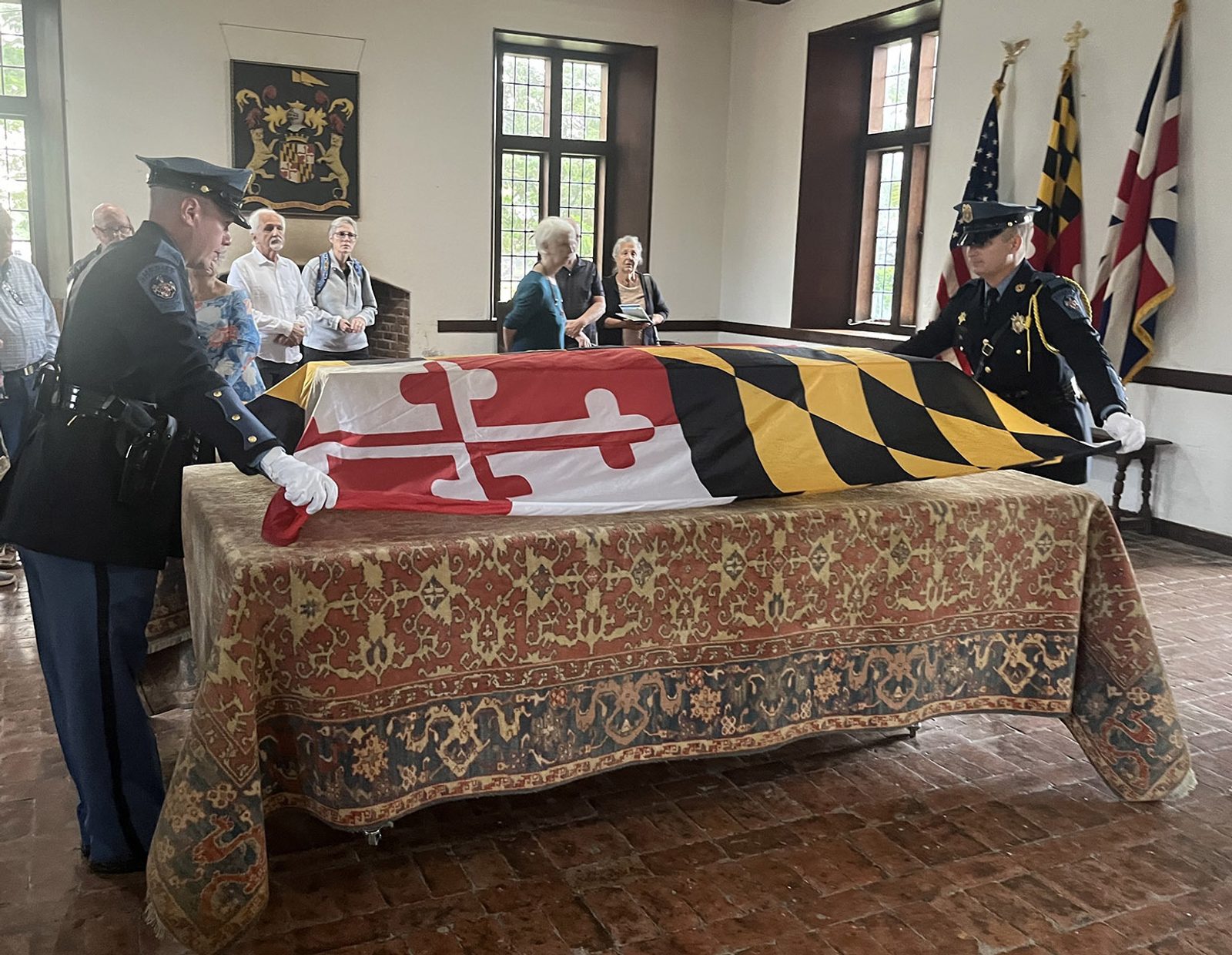
The ceremony began with a procession from the reconstructed State House of 1676 in Historic St. Mary’s City to the Brick Chapel located about one-half mile away. The remains of the eight young children were placed in a pine coffin, a reproduction of a coffin that had been excavated from the chapel site. A flag ceremony included members of the St. Maries Citty Militia wearing colonial garb who carried a 17th century Maryland flag; members of the Society of Colonial Wars in the State of Maryland who carried the American flag, the state of Maryland flag, the Lord Baltimore flag and a 17th century British flag; members of the Knights of Columbus 4th Degree Color Corps who carried a Vatican flag; and members of the St. Mary’s County Sheriff’s Office carrying that county’s flag.
Noah Posey – a student at La Plata High School and a descendant of Francis Posey, who arrived in Maryland around 1640 – played a traditional rope drum as eight descendants of early Marylanders solemnly carried the casket bearing the remains to a hearse that was pulled to the chapel by two Clydesdale horses.
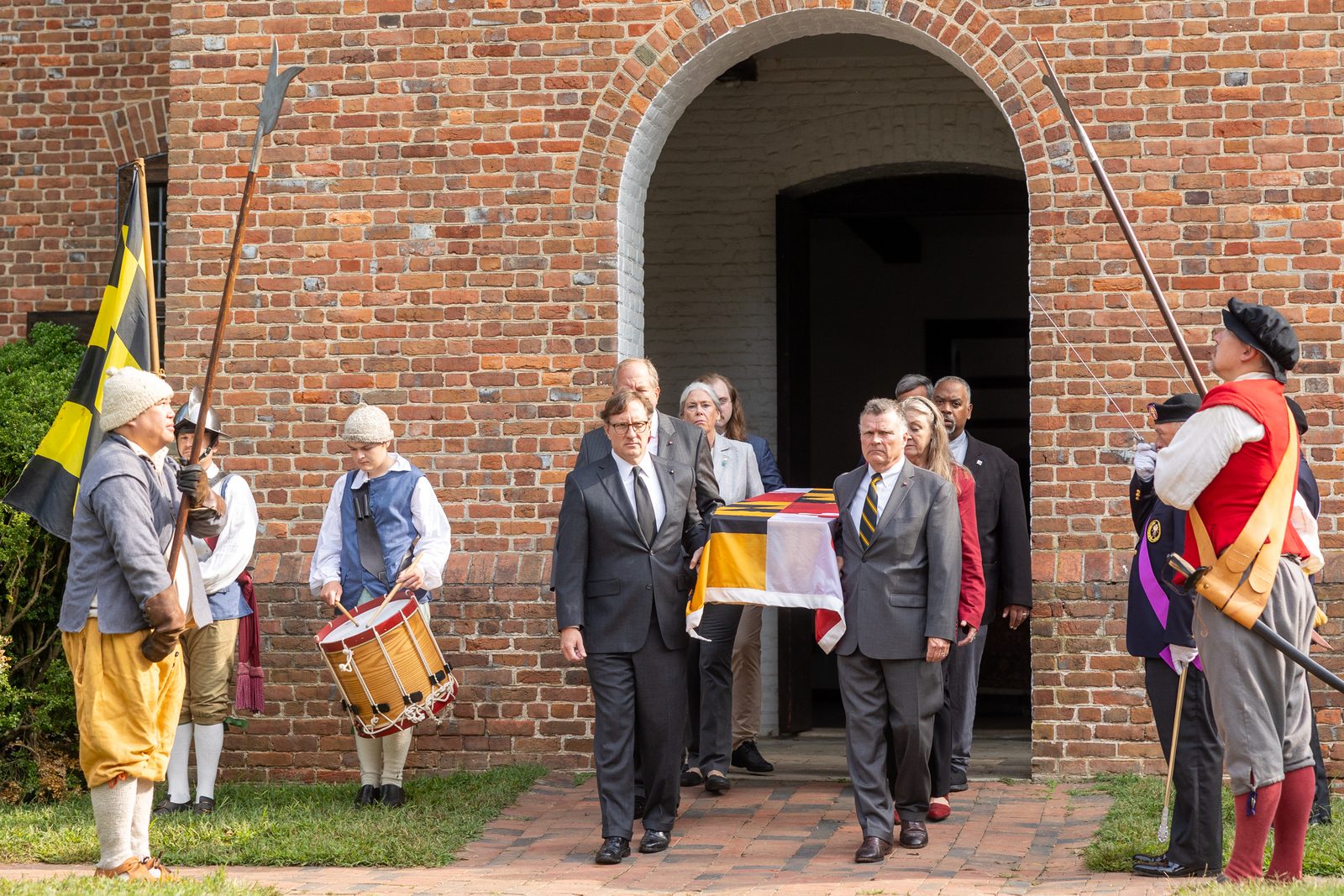


As the reinterment ceremony unfolded at the Brick Chapel, Dr. Henry Miller – an historical archaeologist who helped lead the excavation at the site and the research for the chapel’s reconstruction – noted that the event was the culmination of more than three decades of work, spurred by the discovery of three lead coffins at the site in 1990. Those coffins were found to contain the remains of Philip Calvert, an early governor and chancellor of Maryland, and his wife Anne Wolseley Calvert and an infant son. Philip Calvert was the youngest son of the first Lord Baltimore.
Miller, a Maryland Heritage Scholar and the Senior Research Fellow at Historic St. Mary’s City, said the ceremony offered “the opportunity of directly honoring the actual remains of Maryland’s founders, especially the founding family. Without them, there would be no Maryland. They helped shape the Maryland we live in today and set significant precedents for how people of different faiths and beliefs can live together peacefully in the centuries that followed.”
He noted how in the mid-1990s, the graves within a 10-foot zone around the outside of the original chapel’s brick foundation were excavated so no burials would be damaged by the reconstruction of the chapel. Those remains were then carefully studied by Dr. Douglas Owsley, the curator of biological anthropology at the Smithsonian Institution’s National Museum of Natural History; and by Kari Bruwelheide, a museum specialist in skeletal biology there.
Speaking at the ceremony, Owsley said, “Today for the reinterment of these remains, we are doing more than simply returning them to earth in a carefully designed glass-covered vault. We are opening a transparent window into their lives.”
Owsley said that their research into those skeletal remains offered insights into lives of the people in St. Mary’s City during the 17th century, since bones can reveal clues about things like people’s health conditions and medical treatments and their long hours of work and daily hazards. “Even those lost to history can still tell us who they were, and the stories they tell are not often those found in history books,” he said.
The Smithsonian researcher called the chapel site “a place of memory, of reverence and of historical significance,” and he said it has been a privilege to study the bones of the people who lived in St. Mary’s City during Maryland’s early years as a colony.
“We have served as their caretakers, their guardians,” Owsley said, adding that by shifting one’s gaze, “we begin to recognize them not as distant people, but as us, just generations removed… We see this interment as a continuation of their lives and our own. May they rest well.”
At the ceremony, a message of support was read from Ted Koppel, formerly the longtime anchor of ABC News’ Nightline who with his wife Grace Anne purchased and restored an historic manor in St. Mary’s County and has been a longtime supporter of the Brick Chapel project.
Henry Miller also praised the legacy of the early Marylanders, saying, “They built the foundation upon which we stand. These people laid the foundation for a new civil society called Maryland that is now almost 400 years old, 150 years older than the United States. It grew from a few hundred people to over six million today. Many died trying and others underwent much hardship and struggle to build Maryland.”
He noted how today, many people in Maryland and throughout the United States have family roots in early Maryland.
Those pioneer residents of Maryland, he said, laid the foundation for liberty of conscience and the freedom of religion that later became a cornerstone of the U.S. Constitution.
“In struggling to work out these new ideas, the Marylanders learned a valuable lesson, people of different faiths could live and work together to build the colony. Indeed, from that experience, they learned that people with different viewpoints can live together without violence. That is a legacy as important in late 2025 as it was in the 1600s,” Miller said.
The historical archaeologist also noted another key aspect of the Brick Chapel and the approximately 400 people who were buried in unmarked graves in the field surrounding the chapel site.
“Another foundation they established was one of the major religions in America – the Roman Catholic Church. That church began in English America on this spot. The Catholic faith grew and despite much persecution, survived. Because of that survival, Maryland became the starting point for the new church in the new United States,” Miller said.
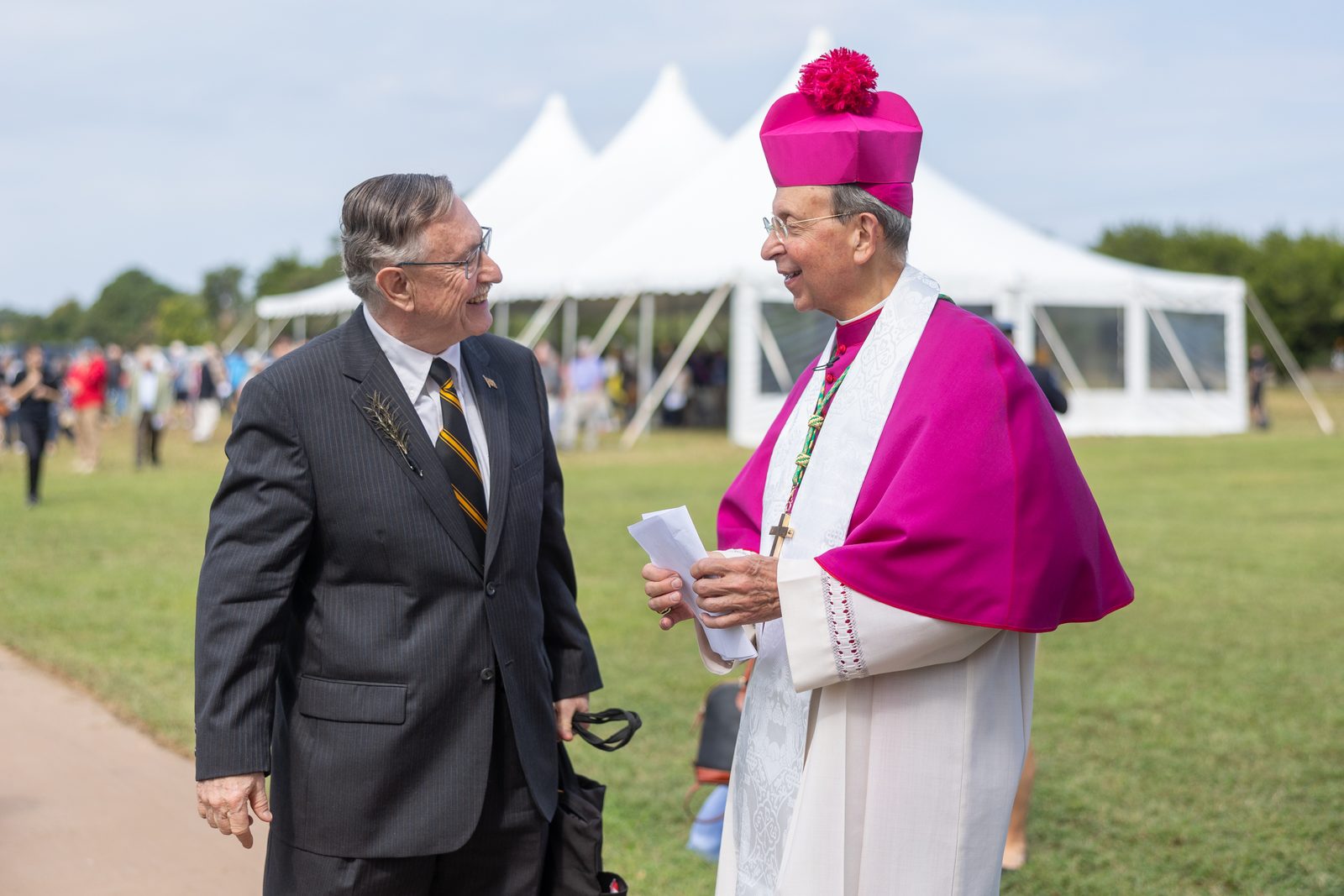
In 1704, the Maryland royal governor at that time ordered the sheriff of St. Mary’s County to lock the door of the Catholic chapel that had been built in 1667, and Catholics in a state founded on religious toleration could no longer worship in public. The chapel was later dismantled brick-by-brick. Religious freedom was restored in Maryland following the American Revolution, and those principles championed by Lord Baltimore about 150 years earlier were enshrined in the First Amendment to the U.S. Constitution in 1791.
The seeds of the Catholic faith planted by the original Maryland colonists eventually developed into the Diocese of Baltimore, the new nation’s first diocese that was established in 1789 to serve Catholics in the 13 original states and was led by Bishop John Carroll, the nation’s first Catholic bishop.
As he began his remarks at the ceremony, Archbishop Lori noted that he was wearing a pectoral cross that once belonged to his predecessor, Bishop John Carroll of Baltimore.
“It is a link to the history that we celebrate, for John Carroll’s forebears worshipped on this site,” he said.

Archbishop Lori also noted his personal link to the site. In 1992, he served as the priest secretary for Cardinal James Hickey, then the archbishop of Washington, who presided at the rite of disinterment for the early members of the Maryland colony buried near the foundation of the 1667 Brick Chapel.
“For them, Maryland itself was an experiment in religious liberty, as well as an ‘incubator’ of human rights,” Archbishop Lori said. He added, “Now, after more than 30 years, we commit their remains in this chapel.”
During the ceremony, the archbishop also blessed the interior of the chapel, sprinkling it with holy water. The reconstructed Brick Chapel, he said, stands “as a testament to the deep-seated quest of these noble souls for religious toleration and for religious freedom as fundamental, God-given freedoms at the heart of human dignity itself.”
Baltimore’s archbishop noted the fragility of religious freedom and toleration throughout the nation’s history.
“It is profoundly challenged in the current climate, where ideological extremes of all ilks drown out voices of toleration, reason and goodwill. Those whose memory we keep today – whose remains we inter in the replica of this chapel where some of them worshipped – they tell us that violence, intolerance and harsh rhetoric undermine the experiment in whose founding they played an indispensable role,” he said.
Noting the upcoming 250th anniversary of the United States in 2026, Archbishop Lori said, “Let us ask these souls to pray for us from their place in eternity, that we might find the wisdom, courage and virtue to mend our societal wounds and to rebuild our political culture.”
Concluding his remarks, Archbishop Lori said, “As we recommit these our forebears to their place of rest, let us recommit ourselves to the protection of religious freedom and all our fundamental freedoms, overcoming threats that might arise whether from law, policy or culture. May this chapel remain for all time a hallowed place and may the souls of the faithful departed interred here rest in peace.”
Miller noted that while the reinterment ceremony involved returning the remains of eight young children, the remains of the rest of the 65 individuals buried at the site had been brought back and placed in the vault at the Brick Chapel earlier.
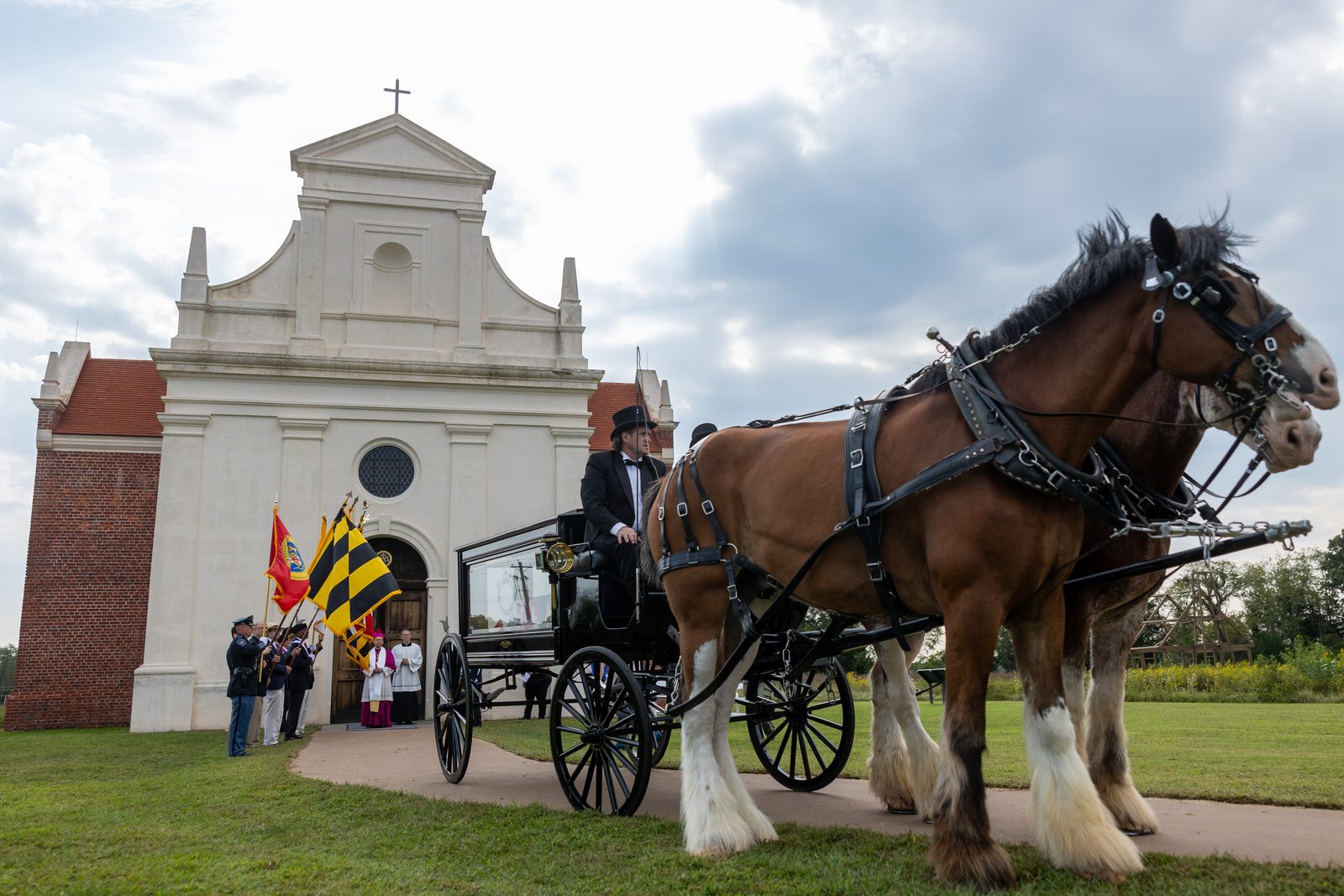
The solemn ceremony continued as eight pallbearers who are descendants of 17th century Marylanders carried the coffin from the hearse to the front of the chapel, accompanied by an honor guard of members of the St. Maries Cittie Militia and Knights of Columbus. Two members of the St. Mary’s County Sheriff’s Office removed and folded the Maryland flag that they had placed on the coffin.
During the Rite of Reinterment, Archbishop Lori blessed the coffin with incense, and he prayed, “Eternal rest grant unto them, O Lord, and let perpetual light shine upon them.”
Dr. Timothy Riordan, the retired chief archaeologist of Historic St. Mary’s City, handed a container holding the remains of one of the children to each of the eight honorary pallbearers, who carried the containers to the burial vault for placement.
The last pallbearer, Peter Pearre, a retired architect who is a descendant of Cecil Calvert, the second Lord Baltimore, carried the remains of Philip Calvert’s baby son, who had been buried in a small lead coffin at the site.
As the ceremony concluded, Jennifer Linhart Wood – the choral director of Trinity Episcopal Church in St. Mary’s City who is an assistant professor of English at George Mason University – sang the Salve Regina, and as she sang, she placed her hand on her heart and looked up at the chapel’s dramatic painting of Mary and the infant Jesus that is based on an icon from the Basilica of St. Mary Major in Rome.
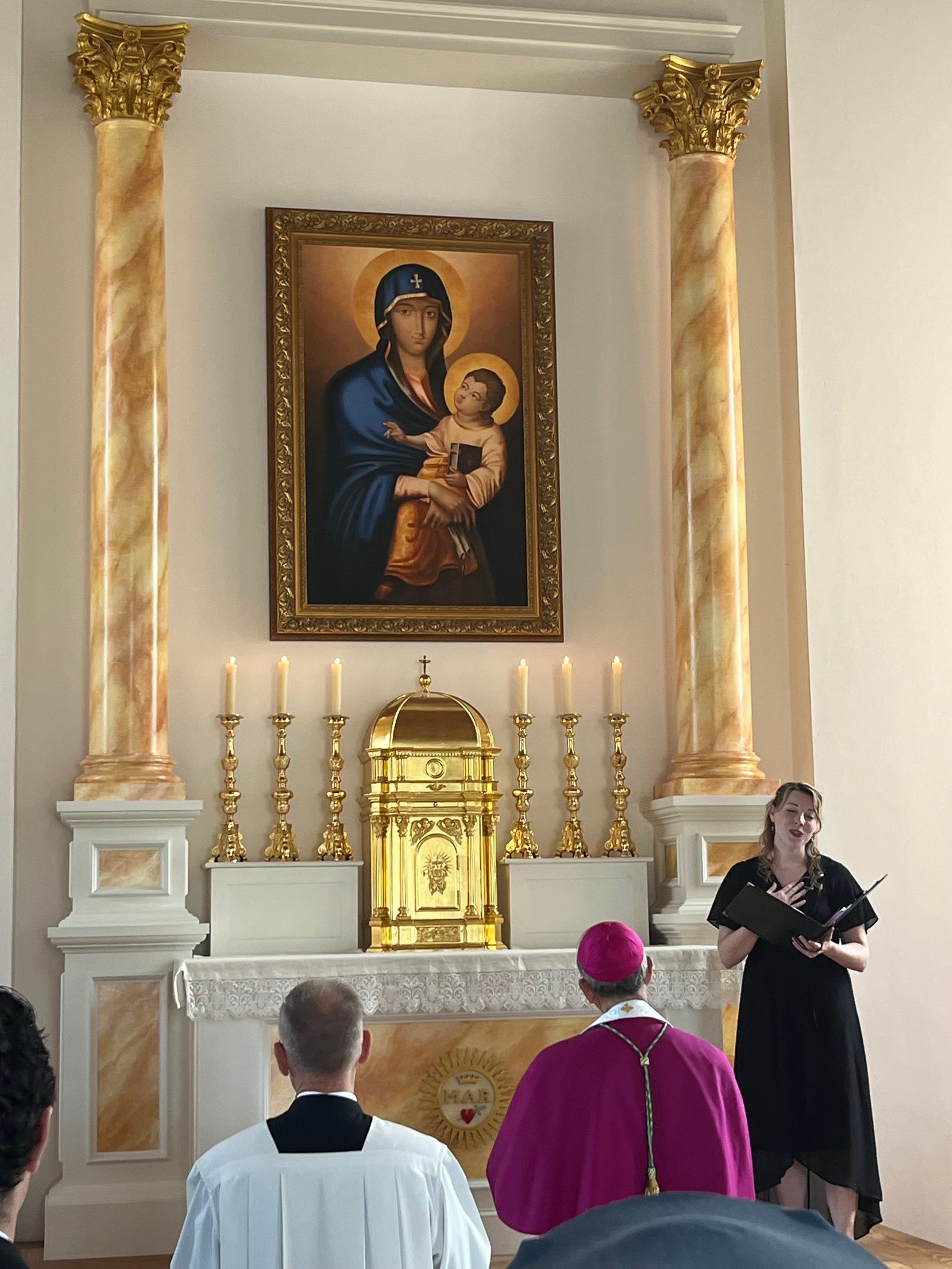
In addition to Archbishop Lori, another member of the clergy who participated in the 1992 disinterment rite and the 2025 reinterment at the Brick Chapel site was Jesuit Father William George, who grew up in St. Mary’s County and served as the president of Georgetown Preparatory School in North Bethesda from 2000 to 2010 and also has served as the chairman of the Historic St. Mary’s City Commission.
Before the reinterment ceremony, Father George reflected on the early Marylanders being remembered that day, and how they were among the founding members of a colony based on religious freedom and toleration. “Whoever you were, you were welcomed,” he said.
The priest said the legacy of those first Maryland colonists resonates today for the people of Maryland and all Americans.
“We need each other, and we need freedom of conscience,” Father George said, adding, “Even though you may have all different ways of looking at life, theologically or politically, we’re all God’s children, and we need each other.”
As he prepared to walk to the Brick Chapel, the priest said, “This is holy ground, every inch of it.”
Related story:
Descendants of early Marylanders participate in ceremony bringing pioneer colonists' remains home
https://www.cathstan.org/local...
Link to photo gallery:











